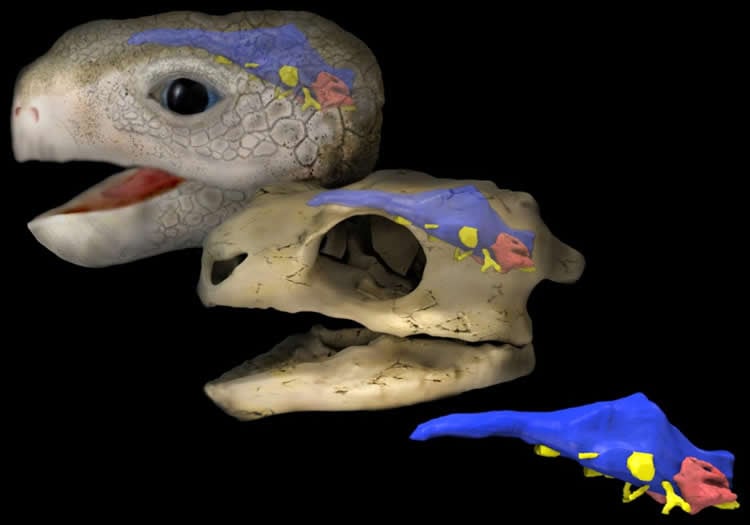Summary: A new study published in Frontiers in Ecology and Evolution reveals turtle brains have evolved slowly, but constantly, over the last 210 million years. The study also reveals the first turtles with fully formed shells were more likely to have lived on land, and not in the water.
Source: University of Birmingham.
A new study led by the University of Birmingham shows that the brain of turtles has evolved slowly, but constantly over the last 210 million years, eventually reaching a variety in form and complexity, which rivals that of other animal groups.
The study also discovered that the first turtles with a fully formed shell were very likely to be living on land and not in water or in an environment where they burrowed underground.
Turtles are one of the oldest vertebrate groups still alive today. Their origins date back nearly 250 million years, yet they have changed very little since then. Almost all fossil turtles looked very similar to modern turtles today and this probably enabled turtles to survive several mass extinctions.
An international team of scientists from the UK, Brazil and Germany used modern computer analysis to look at what happened to the turtle brain over this long period of evolution.
The team’s research, published today (1 February 2018) in the journal Frontiers in Ecology and Evolution, focussed on the fossils of the oldest turtle with a fully formed shell: Proganochelys quenstedti, found in the Triassic sediments (ca. 210 million years) of Germany. Using computed tomography scanning of two fossil skulls, the researchers generated digital models of the brain of Proganochelys and compared them to brain models of modern turtles.
Dr Stephan Lautenschlager, lead author from the University of Birmingham’s School of Geography, Earth and Environmental Sciences, said: ‘Our results demonstrate that Proganochelys, the oldest turtle with a real shell, had a very simple brain structure. Vision and hearing were probably not very good, while the sense of smell was moderately developed.’
Results of this study further showed that the turtle brain increased in size and complexity over the course of evolution to modern turtles. Modern turtles show a wide variety of brain shapes and sizes, which reflects their sensory capabilities and their life styles.

Co-author Dr Ingmar Werneburg from the Senckenberg and University Tübingen, Germany, added: ‘Over a period of 200 million years the brain of turtles became more complex, allowing them to adapt to different habits and living conditions. This is very important as we see similar diversifications in other animal groups such as mammals and birds.’
The team’s results further helped to clarify some mysteries of turtle origins. Different competing hypotheses exist as to whether turtles originated in an aquatic, terrestrial or even fossorial (digging underground) environment.
Gabriel Ferreira from the University of São Paulo, Brazil, who also co-authored the study, explained: ‘By comparing the digital brain reconstruction of Proganochelys with those of modern turtles we can show that the first turtles with a fully formed shell were very likely living on land and not in the water or in an fossorial environment. It was only later that they explored those different habitats.’
Source: Kate Chapple – University of Birmingham
Publisher: Organized by NeuroscienceNews.com.
Image Source: NeuroscienceNews.com image is credited to Stephan Lautenschlager, University of Birmingham.
Original Research: Open access research in Frontiers in Ecology and Evolution.
doi:10.3389/fevo.2018.00007
[cbtabs][cbtab title=”MLA”]University of Birmingham “Slow But Steady: Shedding Light on Evolution of Turtle Brains.” NeuroscienceNews. NeuroscienceNews, 1 February 2018.
<https://neurosciencenews.com/turtle-brain-evolution-8415/>.[/cbtab][cbtab title=”APA”]University of Birmingham (2018, February 1). Slow But Steady: Shedding Light on Evolution of Turtle Brains. NeuroscienceNews. Retrieved February 1, 2018 from https://neurosciencenews.com/turtle-brain-evolution-8415/[/cbtab][cbtab title=”Chicago”]University of Birmingham “Slow But Steady: Shedding Light on Evolution of Turtle Brains.” https://neurosciencenews.com/turtle-brain-evolution-8415/ (accessed February 1, 2018).[/cbtab][/cbtabs]
Abstract
Sensory evolution and ecology of early turtles revealed by digital endocranial reconstructions
In the past few years, new fossil finds and novel methodological approaches have prompted intensive discussions about the phylogenetic affinities of turtles and rekindled the debate on their ecological origin, with very distinct scenarios, such as fossoriality and aquatic habitat occupation, proposed for the earliest stem-turtles. While research has focused largely on the origin of the anapsid skull and unique postcranial anatomy, little is known about the endocranial anatomy of turtles. Here, we provide 3D digital reconstructions and comparative descriptions of the brain, nasal cavity, neurovascular structures and endosseous labyrinth of Proganochelys quenstedti, one of the earliest stem-turtles, as well as other turtle taxa. Our results demonstrate that P. quenstedti had retained a simple tube-like brain morphology with poorly differentiated regions and mediocre hearing and vision, but a well-developed olfactory sense. Endocast shape analysis indicates that an increase in size and regionalization of the brain took place in the course of turtle evolution, achieving an endocast diversity comparable to other amniote groups. Based on the new evidence, we further conclude that P. quenstedti was a highly terrestrial, but most likely not a fossorial taxon.






